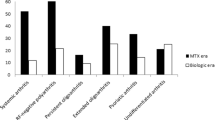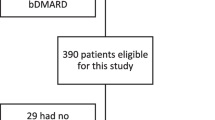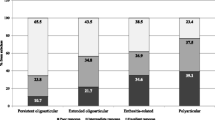Abstract
To assess longitudinally the course and outcome of juvenile idiopathic arthritis (JIA) in patients diagnosed and followed-up exclusively in the biologic era; also, to define possible predictors of the disease progression and need for early implementation of biologicals. Prospective and retrospective, monocentric cohort study of 120 JIA patients, diagnosed between 2001 and 2010, and followed-up for ≥ 4 years (median 8.04). Disease activity, cumulative articular/extra-articular damage and quality of life were evaluated by the assessment tools Juvenile Arthritis Disease Activity Score (JADAS71), Juvenile Arthritis Damage Index (JADI) and Childhood Health Assessment Questionnaire (CHAQ), respectively. Moreover, potential predictors of the disease progression and their relation to biologic therapy were investigated. High JADAS71 score (> 9) at diagnosis was indicative of progression to polyarticular course and the need for early introduction of biologic treatment. Other independent predictors of progression to polyarthritis, were: involvement of upper limb, hip and ankle within 6 months following JIA diagnosis and percentage of cumulative time with active disease > 35% within the first year. At the end of the study, both the median JADAS71 score and the Disability Index were significantly lower than the initial (p < 0.001) and remission off medication was achieved in 25% of the patients. Articular and extra-articular (only ocular) cumulative damage was demonstrated only in 5 and 7.5% of patients, respectively. Physical functional ability was found normal/mildly restricted in 93.3% and moderately restricted in 6.7% of the patients. We believe that these findings, fit in with a picture of JIA course and outcome under current conditions of objective “disease status” evaluation and of tightly controlled follow-up. Predictors emerged from our study could contribute to the identification of patients who will need early implementation of biologic treatment.

Similar content being viewed by others
References
Shenoi S (2017) Juvenile idiopathic arthritis—changing times, changing terms, changing treatments. Pediatr Rev 38:221–232
Giancane G, Consolaro A, Lanni S, Davi S, Schiappapietra B, Ravelli A (2016) Juvenile idiopathic arthritis: diagnosis and treatment. Rheumatol Ther 3:187–207
Guzman J, Oen K, Tucker LB et al (2015) The outcomes of juvenile idiopathic arthritis in children managed with contemporary treatments: results from the reACCh-out cohort. Ann Rheum Dis 74:1854–1860
Cimaz R, Marino A, Martini A (2017) How I treat juvenile idiopathic arthritis: a state of the art review. Autoimmun Rev 16:1008–1015
Consolaro A, Giancane G, Schiappapietra B et al (2016) Clinical outcome measures in juvenile idiopathic arthritis. Pediatr Rheumatol Online J 14:23
Hayward K, Wallace CA (2009) Recent developments in anti-rheumatic drugs in pediatrics: treatment of juvenile idiopathic arthritis. Arthritis Res Ther 11:216
Webb K, Wedderburn L (2015) Advances in the treatment of polyarticular juvenile idiopathic arthritis. Curr Opin Rheumatol 27:505–510
Wallace CA, Giannini EH, Spalding SJ et al (2012) Childhood arthritis and rheumatology research alliance. Trial of early aggressive therapy in polyarticular juvenile idiopathic arthritis. Arthritis Rheumatol 64:2012–2021
Wallace CA (2010) Developing standards of care for patients with juvenile idiopathic arthritis. Rheumatology 49:1213–1214
Wallace CA, Ruperto N, Giannini EH (2004) Preliminary criteria for clinical remission for select categories of juvenile idiopathic arthritis. J Rheumatol 31:2290–2294
Magni-Manzoni S, Ruperto N, Pistorio A et al (2008) Development and validation of a preliminary definition of minimal disease activity in patients with juvenile idiopathic arthritis. Arthritis Rheumatol (Arthritis Care Res) 59:1120–1127
Lovell DJ, Ruperto N, Giannini EH, Martini A (2013) Advances from clinical trials in juvenile idiopathic arthritis. Nat Rev Rheumatol 9:557–563
Solari N, Viola S, Pistorio A et al (2008) Assessing current outcomes of juvenile idiopathic arthritis: a cross-sectional study in a tertiary centre sample. Arthritis Rheumatol 59:1571–1579
Adib N, Silman A, Thomson W (2005) Outcome following onset of juvenile idiopathic inflammatory arthritis. II. Predictors of outcome in juvenile arthritis. Rheumatology 44:1002–1007
Adib N, Silman A, Thomson W (2005) Outcome following onset of juvenile idiopathic inflammatory arthritis. I. Frequency of different outcomes. Rheumatology 44:995–1001
Oen K (2002) Long-term outcomes and predictors of outcomes for patients with juvenile idiopathic arthritis. Best Pract Res Clin Rheumatol 16:347–360
Ravelli A (2004) Toward an understanding of the long-term outcome of juvenile idiopathic arthritis. Clin Exp Rheumatol 22:271–275
Flato B, Lien G, Smerdel A et al (2003) Prognostic factors in juvenile rheumatoid arthritis: a case–control study revealing early predictors and outcome after 14.9 years. J Rheumatol 30:386–393
Arguedas O, Fasth A, Anderson-Gare B (2002) A prospective population based study on outcome of juvenile chronic arthritis in Costa Rica. J Rheumatol 29:174–183
Consolaro A, Van Dijkhuizen EHP, Espada G et al (2017) Development of new JADAS and cJADAS cut-offs for disease activity states in oligoarthritis and RF-negative polyarthritis from a large multinational cohort of children with juvenile idiopathic arthritis. Pediatr Rheumatol 12(Suppl 2):64
Swart JF, Van Dijkhuizen EHP, Wulffraat NM, De Roock S (2018) Clinical Juvenile Arthritis Disease Activity Score proves to be a useful tool in treat-to-target therapy in juvenile idiopathic arthritis. Ann Rheum Dis 77:336–342
Nordal E, Zak M, Aalto K, Berntson L, Fasth A, Herlin T et al (2011) Ongoing disease activity and changing categories in a long-term nordic cohort study of juvenile idiopathic arthritis. Arthritis Rheumatol 63(9):2809–2818
Pratsidou-Gertsi P, Vougiouka O, Tsitsami E et al (2001) Paediatric Rheumatology International Trials Organisation. The Greek version of the Childhood Health Assessment Questionnaire (CHAQ) and the Child Health Questionnaire (CHQ). Clin Exp Rheumatol 19:S76–S80
Petty RE, Southwood TR, Manners P et al (2004) International League of Associations for Rheumatology classification of juvenile idiopathic arthritis: second revision, Edmonton, 2001. J Rheumatol 31:390–392
Consolaro A, Ruperto N, Bazsco A et al (2009) Development and validation of a Composite Disease Activity Score for juvenile idiopathic arthritis. Arthritis Rheumatol (Arthritis Care Res) 61:658–666
Wallace CA, Giannini EH, Huang B, Itert L, Ruperto N, For the Childhood Arthritis and Rheumatology Research Alliance (CARRA), the Pediatric Rheumatology Collaborative Study Group (PRCSG), the Paediatric Rheumatology International Trials Organisation (PRINTO) (2011) American College of Rheumatology provisional criteria for defining clinical inactive disease in select categories of juvenile idiopathic arthritis. Arthritis Care Res (Hoboken) 63: 929–936
Greek Rheumatology Society (2001) Greek Rheumatology Society’s recommendations for the treatment of rheumatic diseases with biologic agents (article in Greek). http://www.ere.gr/Pdf/eresystaseis.pdf. Accessed in 2001
Beukelman T, Patkar NM, Saag KG, Tolleson-Rinehart S, Cron RQ, Morgan DeWitt E et al (2011) 2011 American College of Rheumatology recommendations for the treatment of juvenile idiopathic arthritis: initiation and safety monitoring of therapeutic agents for the treatment of arthritis and systemic features. Arthitis Care Res 63:465–482
Ringold S, Weiss PF, Beukelman T, DeWitt EM, Ilowite NT, Kimura Y et al (2013) 2013 Update of the 2011 American College of Rheumatology recommendations for the treatment of juvenile idiopathic arthritis: recommendations for the medical therapy of children with systemic juvenile idiopathic arthritis and tuberculosis screening among children receiving biologic medications. Arthritis Care Res 65:1551–1563
Cassidy J, Kivlin J, LindsIey C, Nocton J (2006) Ophthalmologic examinations in children with juvenile rheumatoid arthritis. Pediatrics 117:1843–1845
Jabs DA, Nussenblatt RB, Rosenbaum JT (2005) Standardization of uveitis nomenclature for reporting clinical data: results of the first international workshop. Am J Ophthalmol 140:509–516
Duffy CM (2005) Measurement of health status, functional status, and quality of life in children with juvenile idiopathic arthritis: clinical science for the pediatrician. Pediatr Clin N Am 52:359–372
Ruperto N, Ravelli A, Pistorio A, For the Paediatric Rheumatology International Trials Organisation (PRINTO) et al (2001) Cross-cultural adaptation and psychometric evaluation of the Childhood Health Assessment Questionnaire (CHAQ) and the Child Health Questionnaire (CHQ) in 32 countries. Review of the general methodology. Clin Exp Rheumatol 19:S1–S9
Magni-Manzoni S, Pistorio A, Labo E et al (2008) A longitudinal analysis of physical functional disability over the course of juvenile idiopathic arthritis. Ann Rheum Dis 67:1159–1164
Oen K, Tucker L, Huber A et al (2009) Predictors of early inactive disease in a juvenile idiopathic arthritis cohort: results of a Canadian multicenter, prospective inception cohort study. Arthritis Rheum (Arthritis Care Res) 61:1077–1086
Glerup M, Herlin T, Twilt M (2017) Clinical outcome and long-term remission in JIA. Curr Rheumatol Rep 19:75. https://doi.org/10.1007/s11926-017-0702-4
Shoop-Worrall S, Kearsley-Fleet L, Thomson W, Verstappen S, Hyrich K (2017) How common is remission in juvenile idiopathic arthritis: a systematic review. Semin Arthritis Rheumatol 47(3):331–337
Ravelli A, Consolaro A, Horneff G et al (2018) Treating juvenile idiopathic arthritis to target: recommendations of an international task force. Ann Rheum Dis 77(6):819–828
Petty RE, Cassidy JT (2011) Textbook of pediatric rheumatology. Saunders Elsevier, Philadelphia
Marzetti V, Breda L, Miulli E, Filippetti F, Mancini C, Chiarelli F et al (2017) Clinical characteristics of juvenile idiopathic arthritis in an area of central Italy: a population based study. AnIg 29:281–292
Colbert RA (2010) Classification of juvenile spondyloarthritis: enthesitis-related arthritis and beyond. Nat Rev Rheumatol 6:477–485
Angeles-Han ST, Pelajo CF, Vogler LB et al (2013) Risk markers of juvenile idiopathic arthritis-associated uveitis in the Childhood Arthritis and Rheumatology Research Alliance (CARRA) registry. J Rheumatol 40:2088–2096
Moradi A, Amin RM, Thorne JE (2014) The role of gender in juvenile idiopathic arthritis-associated uveitis. J Ophthalmol 2014:461078
Clarke S, Sen E, Ramanan A (2016) Juvenile idiopathic arthritis-associated uveitis. Pediatr Rheumatol 14:27
Heiligenhaus A, Heinz C, Edelsten C, Kotaniemi K, Minden K (2013) Review for disease of the year: epidemiology of juvenile idiopathic arthritis and its associated uveitis: the probable risk factors. Ocul Immunol Inflamm 21:180–191
Angeles-Han S, McCracken C, Yeh S, Jenkins K, Stryker D, Rouster-Stevens K et al (2015) Characteristics of a cohort of children with juvenile idiopathic arthritis and JIA-associated uveitis. Pediatr Rheumatol 13:19
Ravelli A, Felici E, Magni-Manzoni S et al (2005) Patients with antinuclear antibody-positive juvenile idiopathic arthritis constitute a homogeneous subgroup irrespective of the course of joint disease. Arthritis Rheumatol 52:826–832
Ravelli A, Varnier GC, Oliviera S et al (2011) Antinuclear antibody-positive patients should be grouped as a separate category in the classification of juvenile idiopathic arthritis. Arthritis Rheumatol 63:267–275
Martini A (2012) It is time to rethink juvenile idiopathic arthritis classification and nomenclature. Ann Rheum Dis 71:1437–1439
Guillaume S, Prieur AM, Coste J, Job-Deslandre C (2000) Long-term outcome and prognosis in oligoarticular-onset juvenile idiopathic arthritis. Arthritis Rheumatol 43:1858–1865
Al-Matar MJ, Petty RE, Tucker LB, Malleson PN, Schroeder ML, Cabral DA (2002) The early pattern of joint involvement predicts disease progression in children with oligoarticular (pauciarticular) juvenile rheumatoid arthritis. Arthritis Rheumatol 46:2708–2715
Sarma P, Misra R, Aggarwal A (2008) Physical disability, articular, and extra-articular damage in patients with juvenile idiopathic arthritis. Clin Rheumatol 27:1261–1265
De Oliveira Sato J, Corrente JE, Saadmagalhaes C (2011) Progression of articular and extraarticular damage in oligoarticular juvenile idiopathic arthritis. Clin Exp Rheumatol 29:871–877
Author information
Authors and Affiliations
Contributions
Study design: FKT, MT, PPG, PN. Follow-up and recruitment of patients: FKT, MT, PN, PPG. Patient data recording, electronically: PN. Analysis and interpretation of data: PN, FKT, MT, EF. Statistical analysis: PN, PB. Manuscript preparation: PN, FKT. Manuscript critical review: FKT, FP.
Corresponding author
Ethics declarations
Conflict of interest
All authors declare that they have no conflict of interest.
Rights and permissions
About this article
Cite this article
Nalbanti, P., Kanakoudi-Tsakalidou, F., Trachana, M. et al. Juvenile idiopathic arthritis in the biologic era: predictors of the disease progression and need for early introduction of biologic treatment. Rheumatol Int 38, 1241–1250 (2018). https://doi.org/10.1007/s00296-018-4062-9
Received:
Accepted:
Published:
Issue Date:
DOI: https://doi.org/10.1007/s00296-018-4062-9




